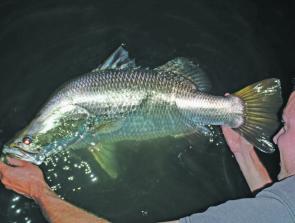The Whitsundays is a wonderful place to be in summer, but sometimes it can get just way too hot! Being out in a tinny in the middle of a sunny, cloudless day with no shade and no wind can become unbearable. However if the fish are on it’s all quickly forgotten
We like to fish when the sun is lower during this time of year. An early morning 5am-9am session or an evening 4pm-8pm trip is better than sweating away like a waterfall in the heat of the day These sessions also coincide with peak feeding hours for most fish species, so it’s a win-win situation.
January is always a great time of year for targeting the pelagic group. Queenfish, golden trevally and GT are the most common species found around the islands and these fish will be feeding aggressively in their warm aquatic environments. If you’re into sportfishing, large GT would have to be the most suitable fish to target this month. The Whitsunday islands are home to a huge amount of big GTs over 25kg. The islands create a vast expanse of fish holding structure. Watching a couple of these large, dark grey shapes come out of the depths and ghost behind your chugging popper or stickbait is always exciting, not as exciting as the succession of torpedo like attacks that follow. If you hook one make sure you hold on.
At other times, the strike will be different. You’ll sometimes get a fish that comes out of nowhere, almost as though it has felt the commotion or spotted the lure from deep down and charged straight up to attack. The top half of its body will often come out of the water on the strike which gives you a quick glimpse of the size of the GT. We were recently filming underwater with a GoPro HD camera when we spotted several large GT up to about 20kg. It was interesting to watch them underwater when they aren’t in feeding mode. They move around quite slowly for a pelagic fish and seem to slowly mill around the same location. When they enter into feeding mode though, it’s a whole different story.
Peter Faust Dam is currently about 93% capacity and about a metre below the spillway overflow level. As the wet season develops and February approaches, fingers are crossed for Faust and all of Queensland’s barramundi lakes. The fishing on some of these lakes seems to have just recently started to recover from the overflows of early 2011 where a massive amount of barramundi escaped. As most of the lakes are now close to full capacity, an average wet season could mean even more fish escaping, reducing the quantity of fish and quality of fishing.
The recent fishing on offer at Peter Faust Dam has ranged from good to excellent. With warm water temperatures, barramundi will feed more often throughout the day and night. The best times to fish here are around the sunset or sunrise period. You’ll often find a spike in feeding activity around this time. During the night is also a good time to be fishing. These fish are actively hunting during the night which makes them easier to catch than in the day. The night is also much cooler than the hot summer daylight heat so it’s more of a comfortable time to be on the water. There’s nothing better in fishing than experiencing an action-packed session on barramundi with leaping fish, rod jarring strikes and fish that push past the 100cm mark on your measuring mat.
Reads: 2129
Kerrin with a solid barramundi from Peter Faust Dam caught on a floating Rapala X-Rap.

Cy Taylor gets a close-up look at a 95cm impoundment barramundi before release.

With warm weather in January, fishing during the night is a great option as many fish are actively hunting down baits.

A mid-sized barramundi from Peter Faust Dam caught on a Squidgy Slick Rig rigged on a TT jighead.




